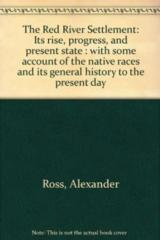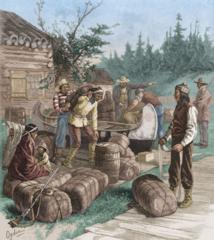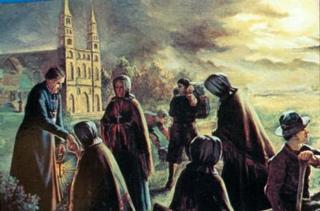Manitoba Evangelization

Who would want to settle in what is now Manitoba? I happily grew up in Winnipeg, but my first views of mountains, when I was about fifteen years old, raised this question. Forty-four years of life in the Himalaya is my answer. I thoroughly enjoy periodic visits home, and even put up with the challenges of a Winnipeg winter in early 1977. I taught at St. Paul's High School then. This summer's reading helped answer my question. (1)
The Hudson's Bay Company came to expand the fur trade, but also opened routes for settlers. Many came from difficult backgrounds. The Scotch settlers arrived in 1812, to begin farming along the Red River. These hardy people had suffered at home, but was life better on their new land? Travel on foot and by boat got them over the ocean, up rivers, and across lakes to their new homes. The soil was good and wood abundant, but there were floods, prairie fires, locust infestations, snowy, freezing winters, and crop failures. Starvation forced travel south to Pembina or north to Norway House. Their hosts were sometimes the peoples of the First Nations who offered hospitality in need.
The Scots rose to these challenges and slowly life improved, thanks to their perseverence. However they lacked pastors. The intial agreement promised them a Presbyterian pastor who spoke Gaelic. They lived without this spiritual guidance for four decades.
The English also came through the Hudson's Bay Company. They establish an administration at Fort Gary and Lower For Gary. Pastors of the Church of England saw to their spiritual needs and did their best to serve the Scots, adapting their liturgical prayers for the Presbyterians. However they could not speak Gaelic and these parishioners struggled with English.
French trappers and traders followed, sometimes working for the North West Company. Some settled and inter-married, forming the Metis community, Catholic missionaries followed and developed missions, first along the Red River and later further west, to serve the First Nations peoples of the plains.
Ross lists his answer to our intitial question. People came to do business. First the fur trade flourished. The annual buffalo hunt provided food and clothing, both for local use and export. The British Hudson's Bay Company supported local industries, including agriculture and livestock raising.
Settlers came to escape difficult lives at home. The Scots doggedly worked through difficulties to establish themselves. English company workers settled on the plains rather than return to England. French traders moved from the east and formed their own communities.
 Missionaries followed to build faith. The Church of England established itself first, and supported the Scots until they finally could set up their Presbyterian parishes. French priests and religious quickly set up missions. These included schools and simple hospitals.
Missionaries followed to build faith. The Church of England established itself first, and supported the Scots until they finally could set up their Presbyterian parishes. French priests and religious quickly set up missions. These included schools and simple hospitals.
Ross praises the Scots who hung onto their their faith without clerical support. He thanks the Church of England pastors who brought spiritual service to their own people and to the Scots. These missionaries also reached out to the First Nations.
The Catholics seem to have been more organized, officially setting up missions which later grew to become dioceses. Religious sisters, especially the Gray Nuns, were important to the success of these missions. 
Ross suggests that the faith will grow only if people settle down. He warns against mixing economic development with faith formation. He paternally suggests that the First Nations be encouraged to settle into life on farms, to give up long hunting trips, to live with their own community, to avoid inter-marrage, and then be evangelized.
We would not accept Ross' advice today, but we hopefully accept his basic suggestion, following St. Paul (I Cor.9:19-21), to be with and for the people we serve. I hope I can take that advice back to the Himalaya.
+++++++++++++++++++++++++
Note: These are the books that Bill refers to:
Alexander Ross, The Red River Settlement, Its Rise, Progress and Present State (Charles E. Tuttle Co., Rutland VT, and Tokyo, Japan, 1972, First published 1856 by Smith, Elder, and Co., London)
J. J. Hargrave, F.R.G.S., Red River (Friesen Printers, Altona Manitoba, 1871)




No Comments